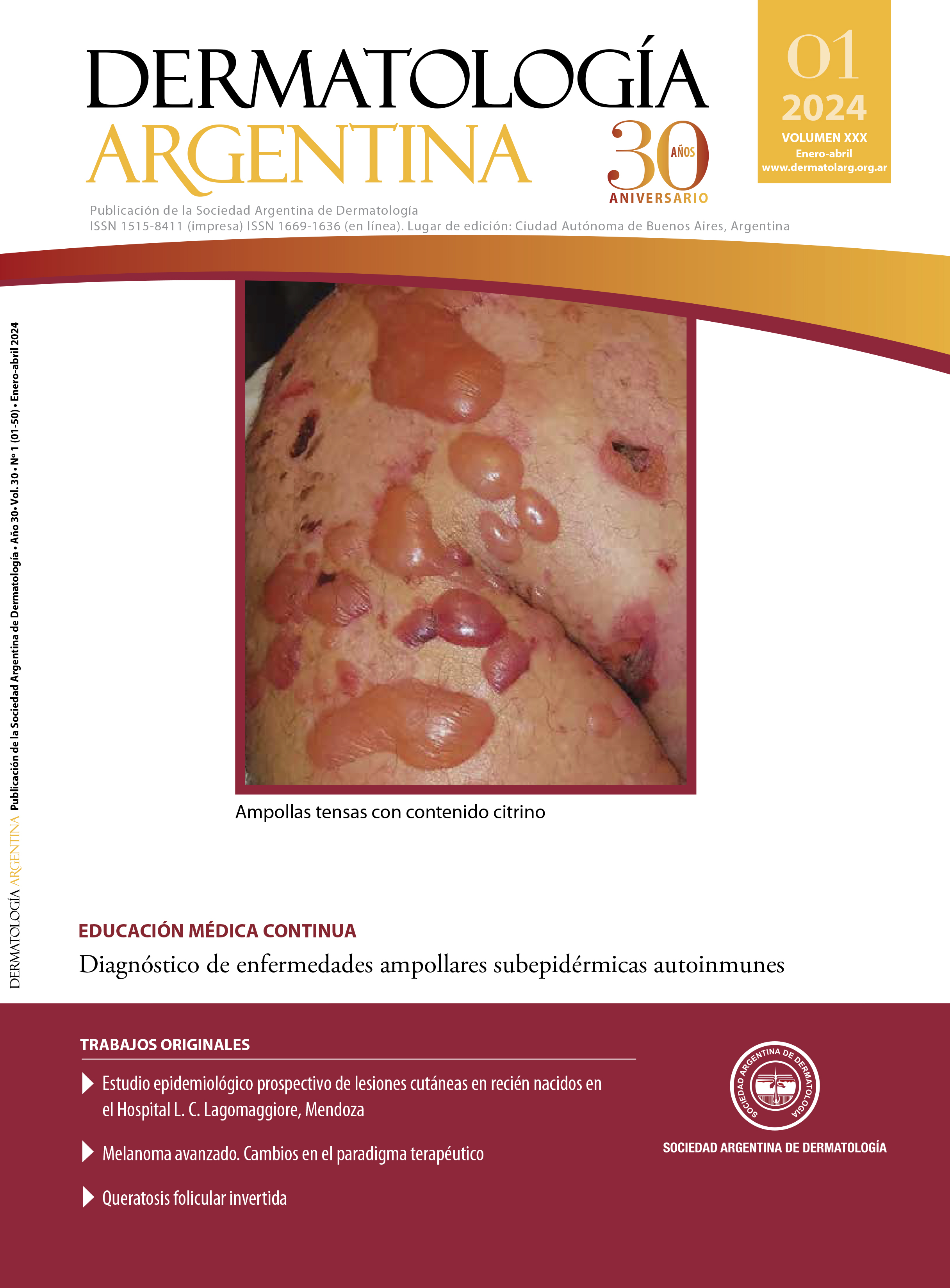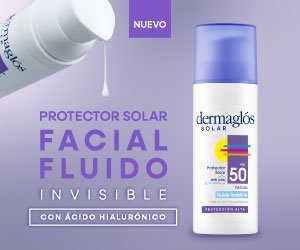Epidemiological study of cutaneous lesions in healthy newborns at L. C. Lagomaggiore Hospital, Mendoza
DOI:
https://doi.org/10.47196/da.v30i1.2458Keywords:
neonatal dermatosis, birthmarks, epidemiological studyAbstract
Background: the skin of the newborn has different functional and structural characteristics than that of the adult. It plays a significant role in temperature regulation, water balance, and barrier against infections. Cutaneous lesions in neonates are frequent and varied.
Objectives: to determine the prevalence of skin lesions in newborns at the L.C. Lagomaggiore Hospital in Mendoza, Argentina; to establish factors that influence the appearance of these lesions; to correlate the results with existing literature.
Design: descriptive, prospective, observational, cross-sectional epidemiological study.
Materials and methods: 160 healthy newborns were evaluated within the first 30 days of life. This study included newly born who were admitted to the joint ward on the first maternity floor, consultations made to the Dermatology Service, and patients from the Neonatal Dermatology follow-up at L.C. Lagomaggiore Hospital, during the period from February to August 2023.
Results: a total of 160 patients were registered. The 52% were females and 48% were males. Of all the newborns (n=160), 95.63% (n=153) presented some form of cutaneous lesion. The five most prevalent entities were: mongolian spot (40.52%; n=62), sebaceous hyperplasia (36.6%; n=56), transient vascular malformation (33.9%; n=52), erythema toxicum neonatorum (30.7%; n=47), and hypertrichosis (23.5%; n=36). The group of benign and transient changes was the most frequent (68.6%). Within this group (n=105), the most frequently found lesion was sebaceous hyperplasia in 53.33% (n=56). Significant association was found between gestational age and desquamation (38-40 weeks p=0.035 and greater than 40 weeks p=0.0008).
Conclusions: benign skin lesions were present in most neonates. It is essential to recognize cutaneous alterations in newborns to avoid incorrect diagnoses, request of complementary exams, and unnecessary treatments.
References
I. Reginatto FP, Villa DD, Cestari TF. Benign skin disease with pustules in the newborn. An Bras Dermatol. 2016;91:124-134.
II. Gualán-Guamangate SP, Espinoza-Jerez GA, Chasi-Chiluisa RA, Acosta-Jaramillo YS. Lesiones cutáneas en el neonato y lactante [en línea]. RECIMUNDO 2022;6(3):54-61. Disponible en: https://recimundo.com/index.php/es/article/view/1648 [Consultado enero 2024].
III. Paller AS, Mancini AJ. Cutaneous disorders of the newborn. En: Paller and Mancini-Hurwitz Clinical Pediatric Dermatology. A Textbook of Skin Disorders of Childhood and Adolescence 6th ed. Elsevier Health Sciences, Missouri 2021;11-12.
IV. Larralde M, Abad E, Luna P, Boggio P, et ál. Enfermedades neonatales. En: Dermatología pediátrica 3ra ed. Ediciones Journal, Buenos Aires 2021;10-17.
V. Miguel J, Barbarot S. Dermatología neonatal. EMC-Dermatología 2018;52:1-27.
VI. Monteagudo B, Labandeira J, León-Muiños E, Carballeira I, et ál. Prevalencia de marcas de nacimiento y lesiones cutáneas transitorias en 1000 recién nacidos españoles. Actas Dermosifiliogr. 2011;102:264-269.
VII. Rodarte-Pérez JI, Oceguera-Angel MP, Castillo-Villarruel F, Ávalos-Huizar X, et ál. Dermatosis en los recién nacidos, hijos de madres adolescentes del Hospital Civil de Guadalajara Fray Antonio Alcalde. Rev Med MD 2016;7:240-246.
VIII. Pogonza AL. Series cronológicas hospitales públicos Mendoza, años 2011-2020. Subprograma Estadísticas de Salud-Departamento de Bioestadística julio de 2021 [en línea]. Disponible en: https:// https://www.mendoza.gov.ar/wpcontent/uploads/sites/7/2022/03/serie_hospitalaria_2011-2020.pdf. [Consultado enero de 2024].
IX. De María MK, Borda KM, Arretche VN, Gugelmeier N, et ál. Epidemiología y factores predisponentes de los hallazgos dermatológicos en neonatos de Uruguay. Actas Dermosifiliogr. 2021;112:414-424.
X. Magaña-García M, González-Campos N. Lesiones cutáneas en un millar de recién nacidos: estudio de casos y controles. Gac Méd Méx. 1997;133(5):407-411 [Consultado de enero 2024].
XI. Dorado-Criado M, Fabra-Garrido C, Rueda-Carnero JM, Molina-Gutiérrez MA, et ál. Mancha mongólica atípica: un reto diagnóstico. Rev Pediatr Aten Primaria. 2018;20:245-247.
XII. Martínez-Lage JF, Villarejo-Ortega FJ, Galarza M, Felipe-Murcia M, et ál. Sinus dérmico sacrocoxígeo: importancia clínica y manejo. An Pediatr (Barc). 2010;73:352-356.
XIII. Delitala A, Capobianco G, Cherchi PL, Dessole S, et ál. Thyroid function and thyroid disorders during pregnancy: a review and care pathway. Arch Gynecol Obstet. 2018;299:327-338.
XIV. 14. Monteagudo B, Labandeira J, León-Muiños E, Romarís R, et ál. Descamación fisiológica en el recién nacido: epidemiología y factores predisponentes. Actas Dermosifiliogr. 2011;102:391-394.
Downloads
Published
Issue
Section
License
Copyright (c) 2024 Argentine Society of Dermatology

This work is licensed under a Creative Commons Attribution-NonCommercial-NoDerivatives 4.0 International License.
El/los autor/es tranfieren todos los derechos de autor del manuscrito arriba mencionado a Dermatología Argentina en el caso de que el trabajo sea publicado. El/los autor/es declaran que el artículo es original, que no infringe ningún derecho de propiedad intelectual u otros derechos de terceros, que no se encuentra bajo consideración de otra revista y que no ha sido previamente publicado.
Le solicitamos haga click aquí para imprimir, firmar y enviar por correo postal la transferencia de los derechos de autor













